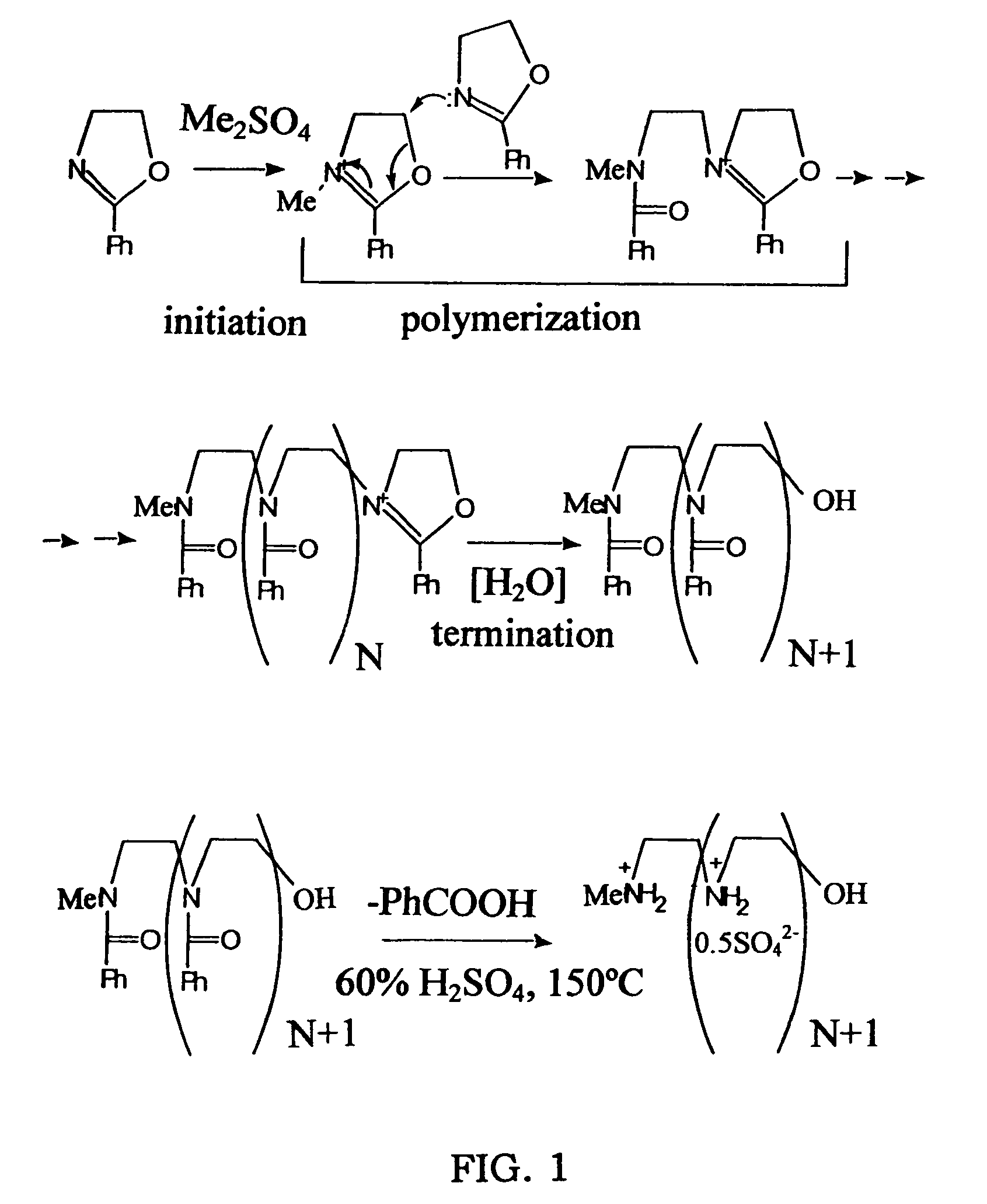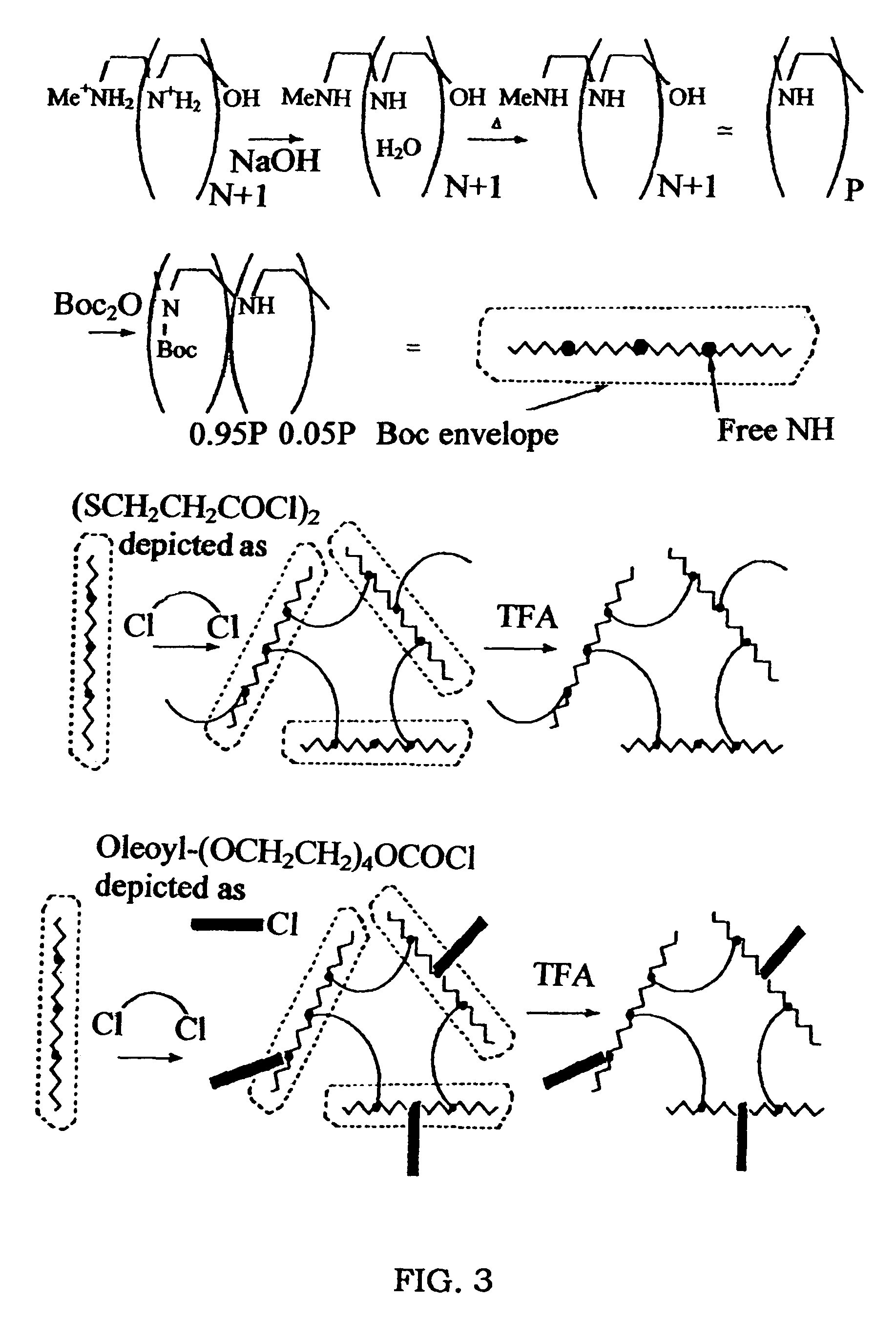Biodegradable cross-linked cationic multi-block copolymers for gene delivery and methods of making thereof
a technology of cross-linked cationic lipids and copolymers, which is applied in the direction of drug compositions, genetic material ingredients, pharmaceutical delivery mechanisms, etc., can solve the problems of limited clinical relevance of cationic lipid-based systems, limited therapeutic applications, and limited practical applications, so as to achieve convenient control of safe and efficient, and easy to control particle size and charge density
- Summary
- Abstract
- Description
- Claims
- Application Information
AI Technical Summary
Benefits of technology
Problems solved by technology
Method used
Image
Examples
example 1
Synthesis of Linear Polyethylenimine
[0059]This example illustrates the preparation of linear polyethyleneimine polymer blocks of the present invention, in form of sulfate salts (FIGS. 1, 2).
[0060]These materials were prepared by a slightly modified Tanaka's procedure.
[0061]Macromolecules, 1983, vol 16, 849-853
1. Purification of Monomer.
[0062]Commercial 2-phenyloxazoline is usually colored (yellow-green to brown) and was distilled in a vacuum (bp 110° / 8 mmHg) to obtain a colorless material. To 300 g of such distillate was added about 45 g of ground (powder) KOH, and the mixture placed in a 500 mL flask. The flask was connected to a rotary evaporator and was then rotated in a 50° C. bath at atmospheric pressure for 4-5 hrs. Yellowish coloration developed. The mixture was filtered through a sintered glass funnel; the solid cake was washed with a small amount of methylene chloride, and then discarded. The filtrates were washed with water (2×100-150 mL), and then dried over Na2SO4. To th...
example 2
Synthesis of a Biodegradable Multiblock Cationic Polymer
[0066]This example illustrates the preparation of a biodegradable multi-block copolymer of 3.6 kD linear PEI (BD3.6K) (FIGS. 3, 4).
1. Linear Polyethyleneimine Free Base.
[0067]A 2 L Erlenmeyer flask was equipped with a magnetic stirrer and charged with LPEI (Mw 3.6 kD) sulfate hydrate (30 g, about 0.15 Mol SO42−), and water (1 L). To the stirred mixture was added NaOH (20 g, 0.5 Mol) and the heterogeneous mixture was warmed to 50-60° C. and stirred for 3 hrs. The mixture was cooled; the precipitated LPEI hydrate was filtered, washed with water, and dried.
2. LPEI3600BOC95%
[0068]A pre-tarred 250 mL flask was charged with LPEI free base hydrate (7.1 g) and connected to a vacuum line. The vacuumized flask was heated to 75° C. in an oil bath. LPEI hydrate slowly converted into a melt of anhydrous LPEI with bubbling. After 3 hrs of heating under vacuum, the brown LPEI melt was cooled, and the flask was flushed with argon. 5.4 g (125 ...
example 3
Synthesis of a Lipid Conjugate of the Biodegradable Multi-Block Cationic Polymer
[0072]This example illustrates the preparation of lipid conjugates of biodegradable cross-linked cationic multi-block copolymers. The biodegradable multi-block copolymers of 3.6 kD linear PEI (BD3.6K) were conjugated with the lipid oleoyltetraethyleneglycolcarbonyl to form BD3.6K-Oleoyl (BD3.6K-O).
[0073]A vial was equipped with a magnetic stirrer and charged with 2.3 g (197 μMol) of LPEI3600BOC95% and 6 mL of dry chloroform. The mixture was warmed and stirred to achieved dissolution, and 150 mg (600 μMol) of dithiodipropionyl chloride (obtained from commercial dithiodipropionic acid and thionyl chloride) in 1.2 mL of chloroform and 110 mg (about 200 μMol) of oleoyltetraethyleneglycolcarbonyl chloride (obtained from commercial polyethylene-glycol monooleoyl ester and phosgene) in 1.2 mL of chloroform were slowly added to the stirred mixture over 10 min. The stirred mixture was kept at room temperature for...
PUM
| Property | Measurement | Unit |
|---|---|---|
| molecular weight | aaaaa | aaaaa |
| molecular weight | aaaaa | aaaaa |
| pH | aaaaa | aaaaa |
Abstract
Description
Claims
Application Information
 Login to View More
Login to View More - R&D
- Intellectual Property
- Life Sciences
- Materials
- Tech Scout
- Unparalleled Data Quality
- Higher Quality Content
- 60% Fewer Hallucinations
Browse by: Latest US Patents, China's latest patents, Technical Efficacy Thesaurus, Application Domain, Technology Topic, Popular Technical Reports.
© 2025 PatSnap. All rights reserved.Legal|Privacy policy|Modern Slavery Act Transparency Statement|Sitemap|About US| Contact US: help@patsnap.com



